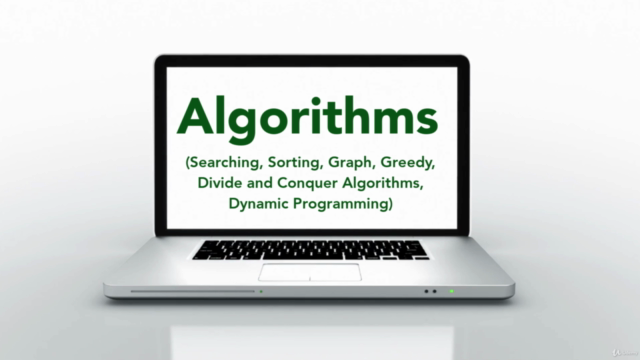The Complete Data Structures and Algorithms Course in Python

Why take this course?
📚 Section 28 - Sorting Algorithms
Sorting algorithms are a fundamental aspect of computer science, used to order data according to specific criteria. Here's an overview of the sorting algorithms discussed:
-
Bubble Sort
- Simple but inefficient for large datasets.
- Works by repeatedly stepping through the list, comparing adjacent elements and swapping them if they are in the wrong order.
-
Selection Sort
- Inefficient on large lists due to its O(n^2) time complexity.
- Divides the input list into two parts: sorted and unsorted. It picks the smallest element from the unsorted part and swaps it with the smallest element in the sorted part.
-
Insertion Sort
- Similar to selection sort, where each new element is inserted into its correct position among the sorted elements.
- Also has an O(n^2) time complexity on average, but can be more efficient if the input is nearly sorted.
-
Merge Sort
- Efficient, stable, and general-purpose comparison sort based on the divide and conquer algorithm.
- Divides the unsorted list into n sublists, each containing one element (a list of one element is considered sorted), then merges sublists two at a time to produce new sorted sublists until there is only one sublist remaining which is the sorted list.
-
Quick Sort
- One of the most commonly used sorting algorithms.
- Based on the divide and conquer approach, similar to merge sort.
- Picks an element as a pivot and partitions the array around the pivot, recursively sorts the sub-arrays, and combines them to produce the sorted array.
-
Heap Sort
- A comparison-based sorting algorithm.
- Works by building a heap from the list, then extracting the elements from the heap one by one in ascending order.
-
Counting Sort
- An integer sorting algorithm that assumes all items being sorted are within a fixed, known range of integers.
- Runs in O(n + k) time where n is the number of elements and k is the range of input values.
-
Radix Sort
- A non-comparison-based sorting algorithm for items inherently capable of being represented as a string of characters (like digits).
- Highly efficient when the key distribution is not uniform (skewed).
-
Bucket Sort
- A sorting algorithm based on dividing the input into several buckets, sorting each bucket individually, and then combing them to produce the sorted list.
- Performance depends on the effectiveness of the pre-sorting algorithms used for each bucket.
-
Tim Sort
- A hybrid stable sorting algorithm derived from merge sort and insertion sort.
- Designed specifically for sorting small and large datasets that are typically encountered in real-world computing, like those with attributes of random data and partially sorted data.
📚 Section 31 - Divide and Conquer Algorithms
Divide and conquer algorithms break a problem into smaller subproblems, solve the subproblems recursively, and then combine the solutions to solve the original problem.
-
Fibonacci Series using Divide and Conquer
- A classic divide and conquer approach to calculate the nth Fibonacci number.
-
Number Factor
- Can be solved using various methods, including divide and conquer.
-
House Robber Problem (Knapsack Problem)
- A problem where you are a thief and have to decide which houses to rob to maximize your gain without getting caught.
-
String Conversion
- Converting one string to another can be done using dynamic programming or divide and conquer strategies.
-
Zero One Knapsack Problem
- A variation of the classic knapsack problem where each item may be chosen at most once.
-
Longest Common Subsequence (LCS)
- The longest subsequence common to all sequences in a set of sequences.
-
Longest Palindromic Subsequence (LPS)
- The longest subsequence in a string which is a palindrome.
-
Minimum Cost to reach the Last Cell
- A problem where you need to find the minimum cost path from one corner of a 2D grid to the opposite corner, given different costs for moving up/down and left/right.
-
Number of Ways to reach the Last Cell with given Cost
- Similar to the above but also considers different paths as distinct ways to reach the destination.
📚 Section 32 - Dynamic Programming
Dynamic programming is a method for solving complex problems by breaking them down into simpler subproblems. It is applicable when the problem can be divided into overlapping subproblems that can be solved independently.
-
Fibonacci Series using Memoization
- A way to store the results of expensive function calls and return the cached result when the same inputs occur again.
-
Number Factor using Dynamic Programming
- Can be optimized using dynamic programming to avoid redundant calculations.
-
String Conversion using Dynamic Programming
- The optimal solution for converting one string into another involves dynamic programming, where a table is filled out with the shortest operations needed to transform any prefix of the source string into any prefix of the target string.
-
Knapsack Problem (0/1 Knapsack and Fractional Knapsack)
- The 0/1 Knapsack problem asks whether a certain number of items with given weights and values can be packed in a knapsack without exceeding a weight limit, maximizing the total value. The Fractional Knapsack problem allows for fractional quantities of items to be taken.
-
Longest Common Subsequence (LCS) using Dynamic Programming
- A dynamic programming approach to find the longest subsequence common to all sequences in a set.
-
Longest Palindromic Subsequence (LPS) using Dynamic Programming
- A dynamic programming solution for finding the longest palindromic subsequence within a string.
-
Edit Distance (Levenshtein Distance)
- The minimum number of operations needed to transform one string into another, which can be computed using dynamic programming.
-
Minimum Spanning Tree (MST) Algorithms
- Algorithms like Kruskal's and Prim's algorithms can find the least costly tree that connects all nodes in a graph.
-
Longest Arithmetic Subsequence (LAS)
- The longest subsequence of a list of numbers where the difference between successive members is constant, which can be solved using dynamic programming.
Dynamic programming and divide and conquer are powerful paradigms for solving complex problems in computer science by breaking them down into simpler subproblems and reusing solutions to those subproblems.
Course Gallery




Loading charts...
Comidoc Review
Our Verdict
[The Complete Data Structures and Algorithms Course in Python](http://comidoc.com) proves valuable for aspiring FAANG candidates with its comprehensive curriculum and animated examples. Despite minor flaws such as repetitive speech patterns, lack of descriptive variable naming, and uneven depth of programming explanations, the course offers an engaging learning experience through numerous exercises and challenges. For those eager to dive deeper into sets or better develop coding skills, supplementary resources or alternative practice platforms may be needed.
What We Liked
- The course covers a wide range of data structures and algorithms with 100+ interview questions to help prepare for FAANG interviews.
- Animated examples are used for deeper understanding and faster learning, which is especially helpful for visual learners.
- Includes time and space complexity analysis, recursion, and Big O notation, allowing students to fully grasp the performance of data structures and algorithms.
- Rich in coding exercises and challenges, enabling students to practice as they learn.
Potential Drawbacks
- Some students find the instructor's repetitive use of phrases like 'so', 'over here', and 'so now' distracting, but this does not affect comprehension.
- The course occasionally delves into excessive detail for some programming examples while providing less detailed explanations for others.
- Code can be harder to follow when using generic variable names like 'i', 'j', and 'k' instead of more descriptive identifiers.
- Although the course introduces a variety of concepts, it does not cover sets, leaving students to seek further resources.